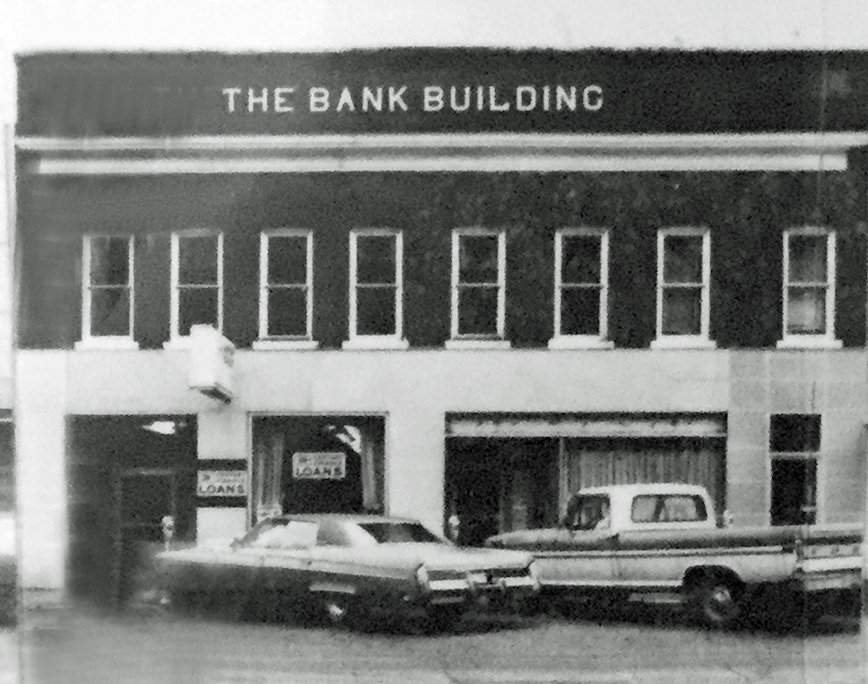Built in 1899, the Bank Building is located at 131 East Laurel Street. It is a two-story brick building with a projecting wooden cornice below a brick parapet. There are eight windows on second floor with stone sills. The ground floor has been altered. The building originally housed the Jackson County Bank and the Post Office. There are three doors associated with this building: two retail locations and one door to the upstairs. The left business is the Kenneth H. Looney law office. The right business is the Morgan Butler law office.
Current view: Kenneth H. Looney and Morgan Butler law offices
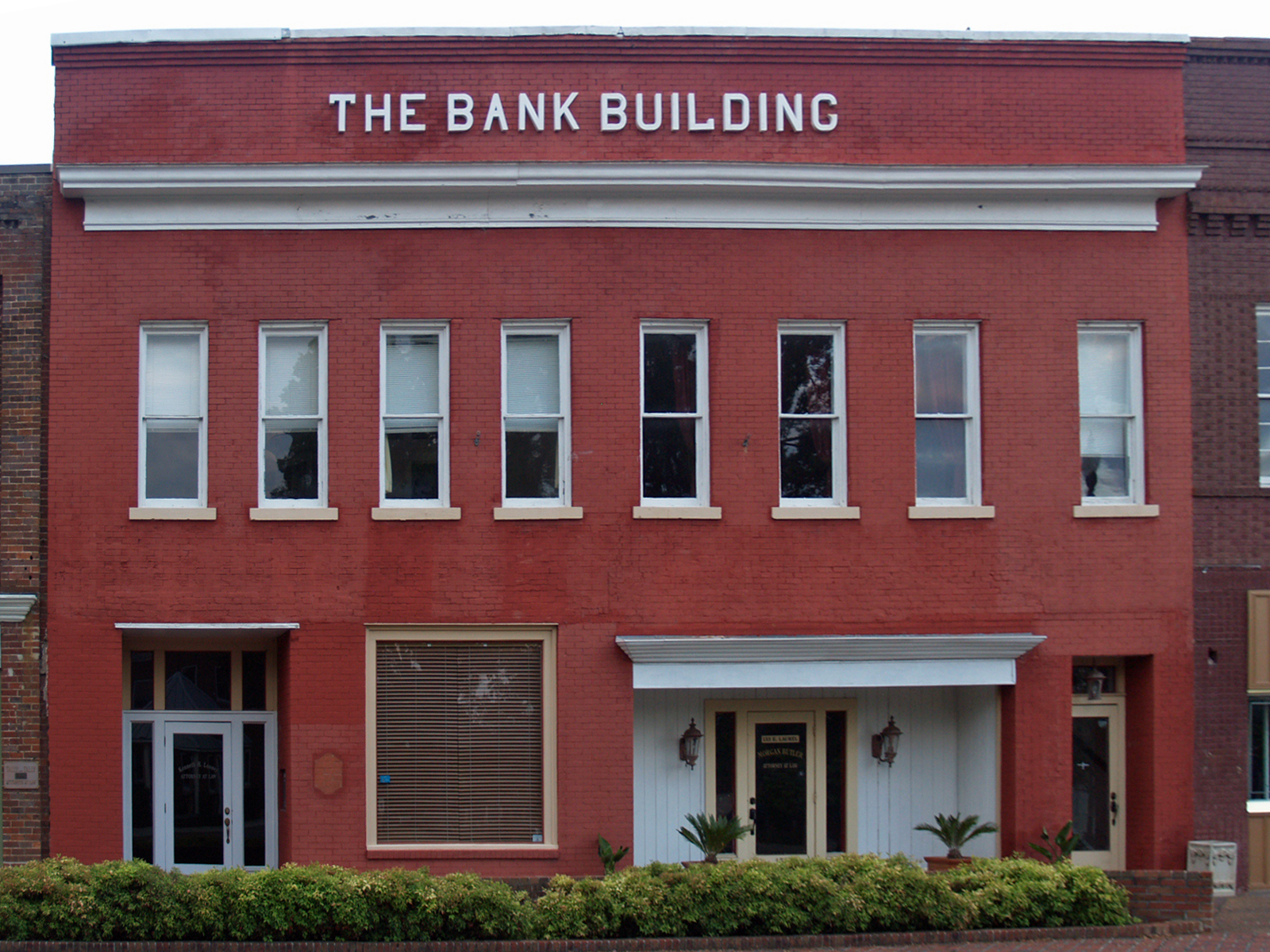
The building was originally home to the Tennessee Valley Bank and later to the State National Bank. The Tennessee Valley Bank in Scottsboro opened in 1899. It was the third office of a state banking chain that opened in 1892 as the Bank of Florence. In December 1905, the bank’s official headquarters was moved to Decatur where the name changed in 1908 to the Tennessee Valley Bank. The bank’s name was changed again in May, 1939, this time to the State National Bank of Alabama. In 1948 the bank pioneered a new form of customer convenience with the first drive-in window in Alabama. In 1964 the First National Bank Bank of Gadsden merged with the Station National Bank of Alabama, followed by another merger in 1969 with the Central Bank and Trust Company of Birmingham. In 1871 Central Bank of Alabama, NA came under the umbrella of a newly-created holding company, Central and State National Corporation of Alabama. The name of the holding company was changed in June 1973 to Central Baneshares of the South, Inc. (Gadsden Times, January 24, 1981).
Deeds, builders, and early owners
Ann Chambless found these deed records for this lot and building:
- J. P. and Ella Rorex to W. A. Coffey and R. C. Ross, Deed Book 18, p. 510-511, dated Sept 1, 1890, Consideration: $1100.00, Lot No. 5 fronting the north side of public square, commencing one foot west of the west corner of Dr. James P. Rorex's office formerly owned and occupied by Robinson and Brown as a law office, and running west with public square to and including one-half of the east wall of brick store house of H. H. Horton and running back to James Armstrong's line.
- Deed Book 25, page 390, dated January 15, 1894, Consideration: $6,000.00 R. C. Ross to Ida Ross, lot on north side of public square fronting 33 feet on square and known as BANK BUILDING LOT, bounded on south by public square, on east by J. P. Rorex, on west by lot owned by W. D. Parks, on north by James Armstrong lot.
- Deed Book 25, pages 549-550, dated April 5, 1894, Ida Ross to R. A. and W. A. Coffey (same description of Bank Building lot as in the deed from J. P. and Ella Rorex to W. A. Coffey and R. C. Ross). After Ross was killed by the Skelton Brothers over the honor of their sister Annie Skelton, the baby and darling of the family, Mrs. Ross no longer wanted to live in Scottsboro and sold her husband’s interest in this bank to W.A. and R. A. Coffey.
Speculating about what major change had ensued between Deed 1 (1890) and Deed 2 (1894) to make the value of site increase six fold, Ann wrote, “Since the Bank Building is a two-bay building and according to old photos housed two types of business houses throughout the 1900s, I suspect the reason for the jump in selling price was because the Dr. and Mrs. Rorex built on their 33 front lot before they sold their property to Coffey and Ross. It is highly possible that the original bank was in the Rorex building.” The bank business at this address was initially known as Merchant’s Bank.
But, Ann continued, “When Coffey and Ross or the officers of the Merchants Bank decided they needed a larger building, they purchased the second 33 foot lot and encased the existing Rorex building into their bank building. Most likely the facade as we know it today was constructed in 1899 to cover the fronts of both buildings making it appear as one unit. Harry Campbell did a beautiful job of restoring this building in the 1980s. Wish Harry were still alive to tell us what he learned during his refurbishing project.”
Founders of Merchant’s Bank
Who were these men who founded Merchant’s Bank is Scottsboro, the W. A. Coffey and R. C. Ross associated with Deed #2? They were later the first officers of the Tennessee Valley Bank.
Weighstill Avery Coffey Sr. was born August 26, 1837 and died July 20, 1898. W. A. Coffey, Sr. married Sarah Elizabeth Harris. He mentioned his 6 children as: A. H. Coffey: Rice A. Coffey; Eula Lee Coffey Howard (Mrs. Wm. W Howard); W. A. Coffey, Jr.; Mayme Coffey; and Vivian Coffey. In his Will Weighstill Avery Coffey, Sr. "authorized and empowered" his Executor to continue and carry on the banking business of the JACKSON COUNTY BANK with the surviving executors of his deceased brother, Rice A. Coffey, "until the month of April 1899 and for the further time as in the judgment of my executor may be in the best interest of all concerned.”
NOTE: At the time of the 1900 census, John C. Jacobs was listed as PRESIDENT OF JACKSON COUNTY BANK, Weighstill Avery Coffey's son Rice A. Coffey was cashier in bank and lived with his sister and brother-in-law, Wallace and Eula Lee (Coffey) Howard. In 1900 census, Wallace Howard was listed as bookkeeper in bank.
RICE ABNER COFFEY, SR. was born December 24, 1836 and died April 9, 1896. In his Will, he mentioned his banking and mercantile business at Scottsboro in which he was interested with his brother, W. A. Coffey, and his mercantile business at Coffey's Store at Rash. He spoke of his country residence as Coffey's Store. He directed his Executor to pay to his wife the sum of $1,000.00 per annum to be employed in maintenance of herself and their minor children and to provide for their education. His unmarried children were to have "a free home in his family." He willed to his daughter, Mary Annie, the sum of $200.00 per annum and the "homeplace" that consisted of 1840 acres. He directed that his debts including one-half the indebtedness of the JACKSON COUNTY BANK and of the Scottsboro store be paid out of rents from his land. He willed land to his daughter Theodocia Coffey Halliburton and Nancy Elizabeth Coffey Jacobs (both from his first marriage to Mary Ann Coffey on October 29, 1857. Mary Ann died on March 28, 1864, and Rice married Sarah Jane Helton on September 11, 1870. He mentioned his 7 children by his present wife (Sarah Jane Helton Coffey) as being: Pleasant H. Coffey; Angeline Coffey; Weighstill Avery Coffey; Sallie Belle Coffey; Rosena C. Coffey; John N. Coffey; and Charles H. Coffey. His widow, Sallie J. Coffey, was living at Rash with their minor children at the time of the 1900 census.Rice Abner Coffey, Sr. nominated his brother W. A. Coffey, his son-in-law, J. C. Jacobs, Sr., and his son, Pleasant H. Coffey as his Executors. His Will was proved on April 23, 1896 (two weeks after his death).
This information gives us the vitae, death dates, and death wishes of these Coffey brothers but does not give us the date their banking interests were sold to Merchants Bank owners. HOWEVER, I found it interesting that John C. Jacobs was listed as PRESIDENT, JACKSON COUNTY BANK, in 1900 census.
1900: Merchant’s Bank becomes Tennessee Valley Bank
THE PROGRESSIVE AGE, dated May 15, 1908, CHANGE IN NAME. The name of the Merchants Bank has been changed to the Tennessee Valley Bank. This is a very appropriate name as the branches of the bank are scattered through the Tennessee Valley.
THE SCOTTSBORO CITIZEN, dated April 22, 1909 BANK'S NEW QUARTERS. The Tennessee Valley Bank, formerly the Merchants Bank, has bought the Parks brick building on the north side of the public square, the price being $2300.00. The building is to be remodeled and converted into an up-to-date bank building, and the bank will move into it some time during the summer.
In the Nov 18, 1909 Scottsboro Citizen, this notation is found: “The Tennessee Valley Bank have moved into its handsome new quarters.” A 1911 ad shows the bank officers: S. S. Broadus, President; P. B. Timberlake, Vice-President; and O. C. Hackworth, Manager:

According to Hubert Bradford Howland in The History of Jackson County, Alabama, Weightstill Avery Coffey was named president of Tennessee Valley Bank in February, 1889 and in March 1892 opened a general store in Scottsboro with his brother Rice Abner Coffey and J. W. Moody. One of Weightstill’s daughters, Mary Hudson Coffey, married Charles Shaw Howland March 7, 1907 in the First Baptist Church. Charles “built the three story Howland Building and notes that “at the time it was erected it was the largest of its kind in the area.”
Upstairs tenants in the 1950s and 1960s
In the 1956 phone book, this building is home to State National Bank of Decatur and the C. O. Reed Agency. In the 1961 phone book, this location was still home to State National Bank but also to O. G. Whitaker Insurance, C. H. Moore Real Estate, and H. O. Weeks, Attorney. In the 1966 phone book, this location is still home to State National Bank but also to the following:
- 131 American-Amicable Life Insurance Company
- 131 R. B. Derrick Real Estate
- 131 Clarence H. Moore, Real Estate
- 131 C. O. Reed, Insurance
- 133 H. O. Weeks, Attorney
In the 1975 photo below, the building on the left appears to be a loan business.
For other views of this distinctive building, see North Side of the Square.
This photo of the Garland Building and the Bank Building from 1917 was part of the set purchased off Ebay.
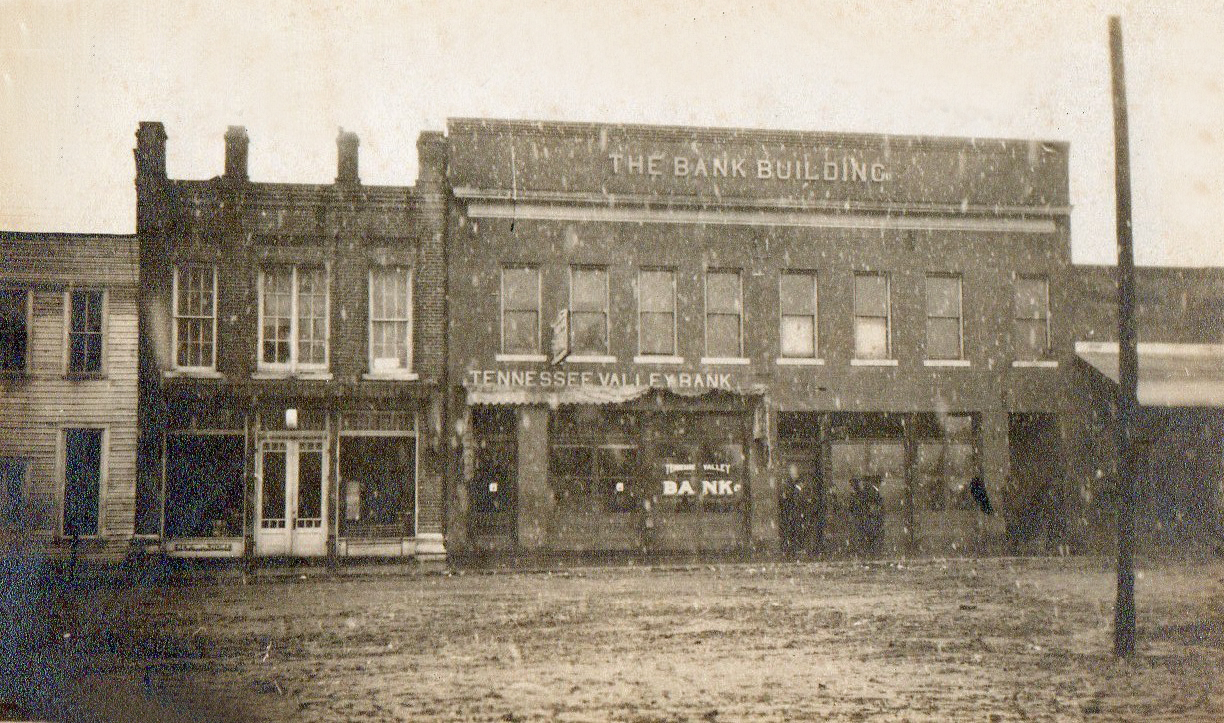
Here is the most famous historical photo of the bank building. There is a hand-tinted version of this photo used as a postcard.
About 1920
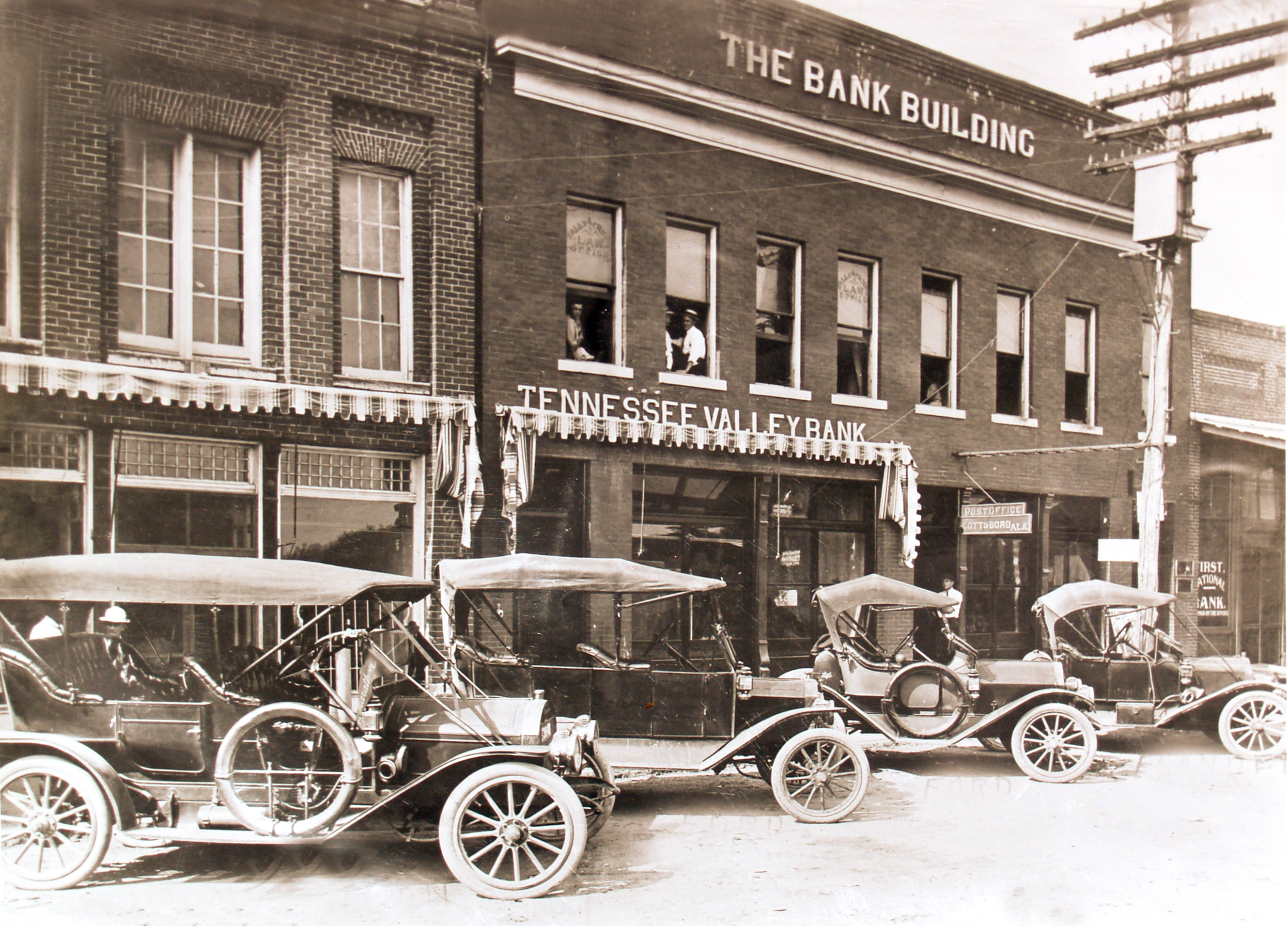
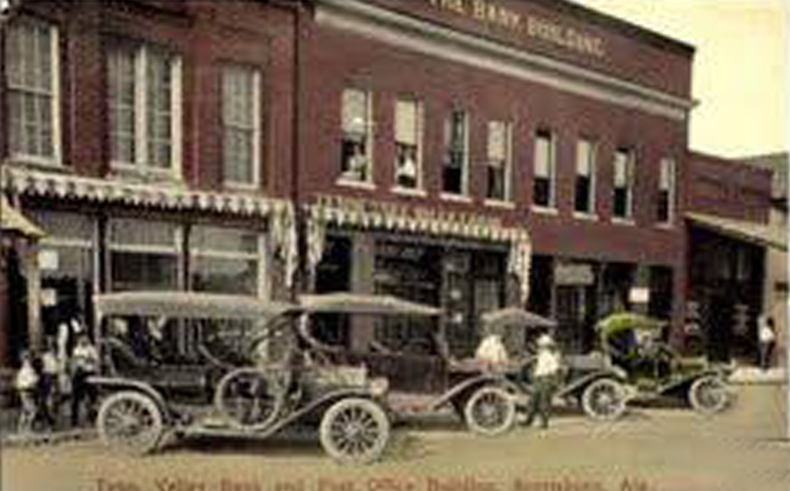
1913: check on Tennessee Valley Bank
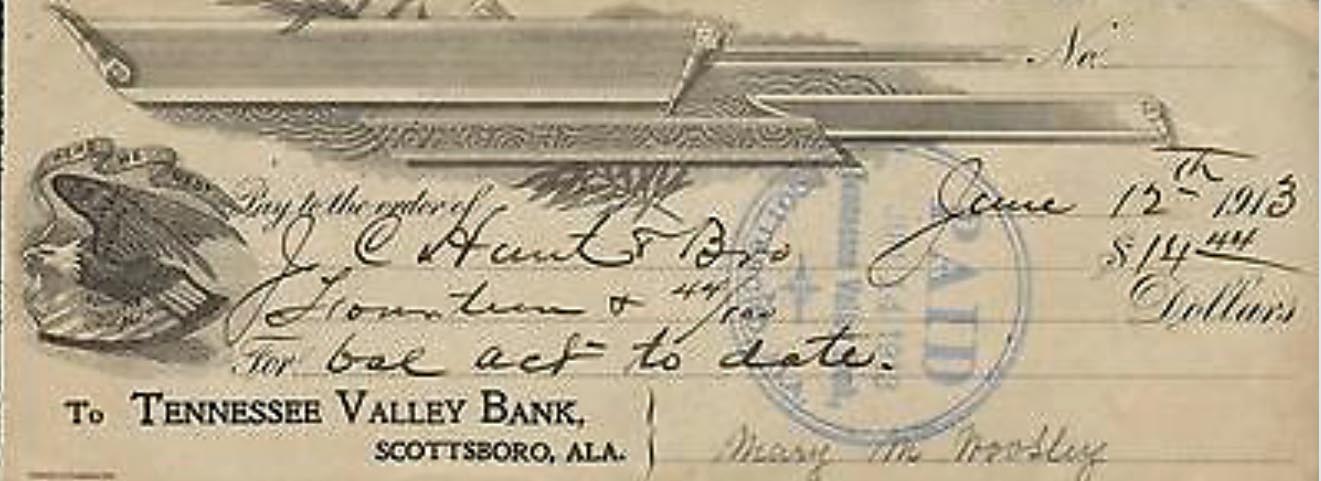
1930: Tennessee Valley Bank ad in the yearbook
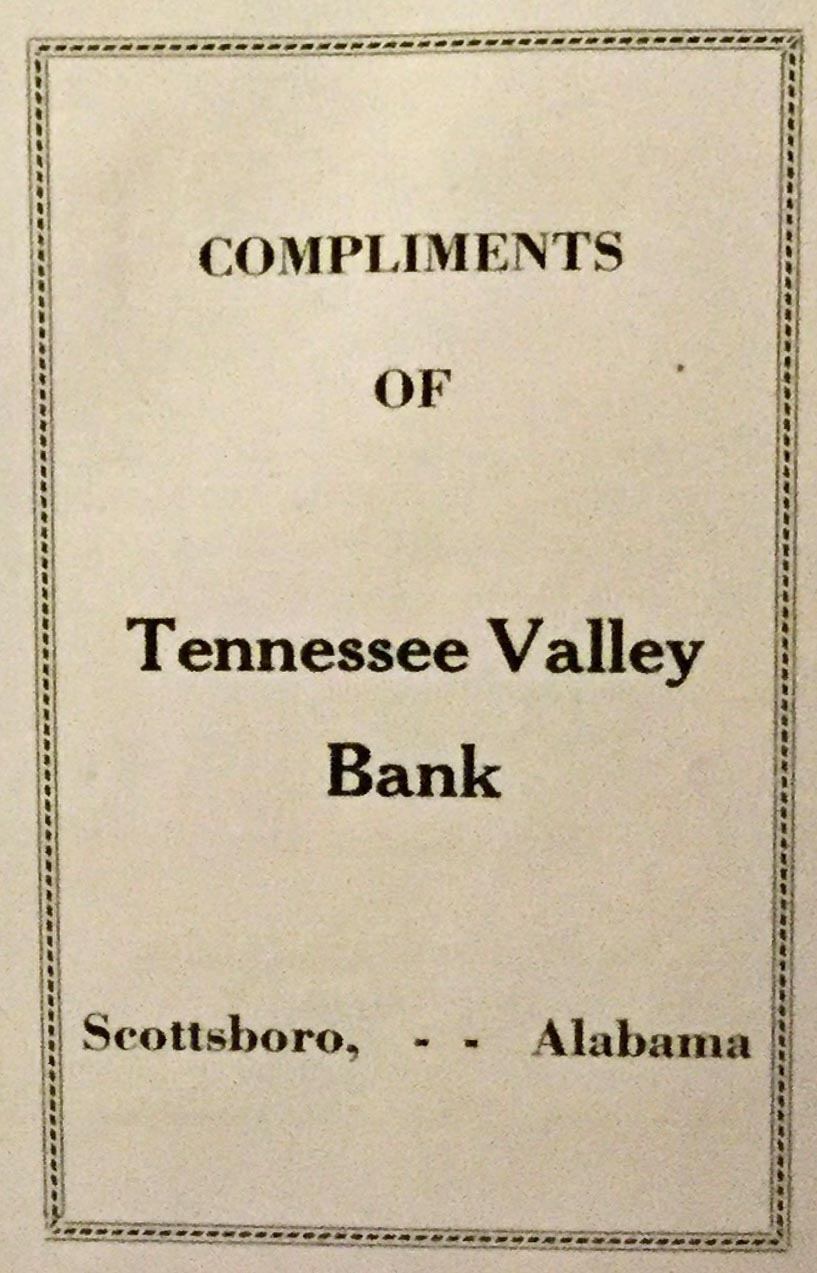
Early 1960s homecoming parade
Notice this good photo of a homecoming parade, which confirms that State Bank still occupied the Bank Building.
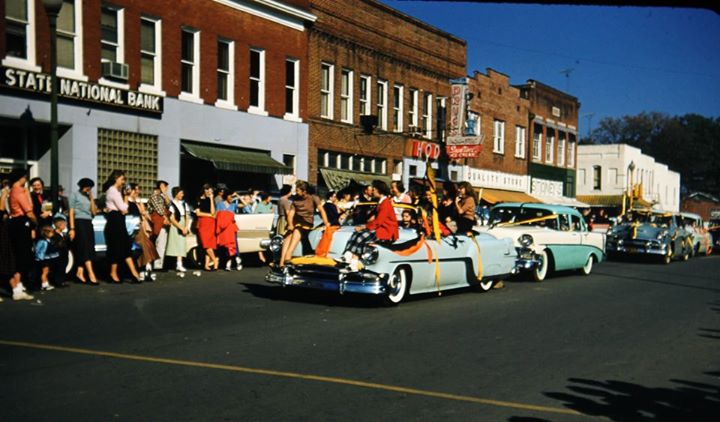
1975: Bank Building with unidentified tenants
